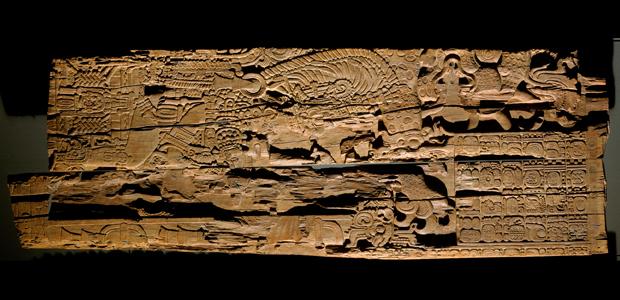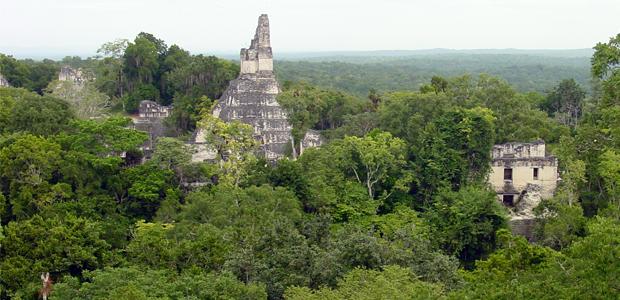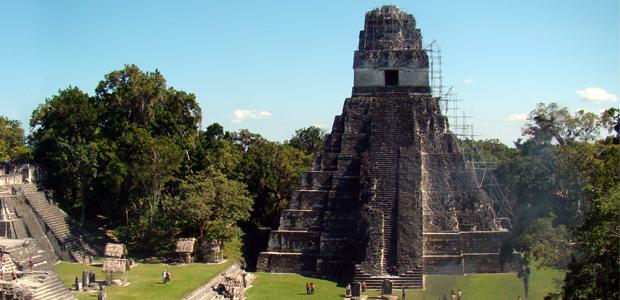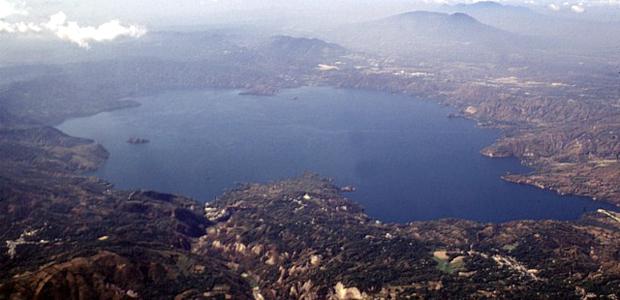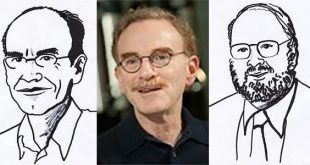A Maya carving has helped an international team of researchers to re-sync the European and Maya calendars and helps show that climate change played a role in the civilization’s collapse.
Carved onto a wooden beam that once hung from the roof of a temple in Tikal, is the story of King Jasaw Chan K’awiil and his victory over the ruler of Calakmul on 9.13.3.7.18 – a date representing the number of Bak’tuns, K’atuns, Tuns, Winals and Kins that have passed since Maya year zero.
Known technically as a lintel, an international team of researchers have determined its age – using advanced radiocarbon dating techniques and cool laser technology – and used the information to re-sync the Maya and European calendars.
“The Maya are probably best known for their stone monuments, but we can’t directly date that material,” Douglas Kennett, study co-author and professor of environmental anthropology at Penn State, told SciFare.com.
The lintel they tested is just one of only a handful known to even exist and researchers found that based on the radiocarbon dates, it was carved sometime between 658 and 696 AD – the original radiocarbon experiments published in 1960, found it was carved sometime between 695 and 712 AD.
Based on the most widely accepted equation, known as Goodman-Martinez-Thompson correlation – it adds 584,283 to the number of Maya days, to get a European calendar date – the Maya date of 1,390,838 corresponds to 5 August 695 AD, falling within the range of both experiments.
Before the site was radiocarbon dated though, equations like the GMT correlation were all researchers had to sync the calendars – it syncs by documenting relative ages that happen to be written in both calendars.
The 1960 analysis may have supported the GMT correlation, but it couldn’t actually discount other competing equations.
Despite missing as much as 15 years of tree growth from milling the tree into a lintel, the innovation in radiocarbon technology allowed researchers to finally exclude competing methods to the GMT correlation.
“We’re sampling close to an individual year in each of our samples,” Kennett said.
That turns out to be a practical achievement as much as it is a bonus for preserving the antiquity of the wood – understandably, nobody wants to chop up an important part of Maya history if they don’t have to.
By nature, the smaller sample size alone leads to more accurate results – if every tree ring is a birthday and the radiocarbon sample requires the first three, it may give an age more closely related to the average than the first.
It works by extracting a single component of the tree’s trunk called cellulose – it acts like collagen does in bones to give them their rigidity and flexibility. The support molecule gives researchers a date based on the year it was formed – which is why sampling a single year is important.
Combined with an overall increase in the technique’s accuracy, it’s allowed researchers to date sites around the world and with an astounding amount of precision.
Poor preservation and a dense layer of resin makes it difficult type of tree to work with – turns out those qualities may also have made it a good candidate canvas for preserving the victory carved on its surface.
“It’s incredibly difficult to even core into modern trees,” Kennett said. “To remove wood and carve it would have been very difficult with the stone age technology they had.”
In fact, the lintel researchers analyzed hadn’t been squared off completely, allowing them to sample very close to the outermost layer.
The type of wood made it a good candidate for analysis with a cool laser technology – known boringly as laser ablation-inductively coupled plasma-mass spectrometry.
The laser measures levels of calcium preserved within the tree’s rings as it accumulates over time. After analyzing similar trees in the area, the researchers noticed an annual bump in the level of calcium that could be measured.
“Each of the peaks in calcium reflects a wet season where calcium’s mobilized from the limestone rich geological environment,” Kennett said. “That calcium basically is drawn up into the tree and deposited.”
Essentially, they take sequential radiocarbon measurements and then count the calcium peaks between them since they can’t reliably count the tree’s rings.
“Then we used the number of those cycles in between the radiocarbon dates to establish a true age,” Kennett said.
The laser technique also helps to harness some of the quirky features associated with radiocarbon dating. Carbon-14 may decay at a steady rate, but levels in our atmosphere have fluctuated through time.
The span of history in question happens to fall in one of those quirky regions – a plateau where very little change in radiocarbon levels can be seen. Using a not-so-technical term known as wiggle-matching, the researchers account for variation in radiocarbon dates by aligning them to the calcium levels.
That’s because no matter how quirky the radiocarbon levels get, it doesn’t change the fact that, for example, 14 calcium spikes between radiocarbon dates can’t correspond to anything other than a 14 year difference.
The refined dating series also allows them to make other statements about important events related to the King of Tikal and even the region in general – the role climate change played was intimately explored in 2012 manuscript published by an international team, including Kennett, in the journal, Science.
“We looked at warfare events that were recorded on stone monuments throughout the region,” Kennett said. “We looked at the frequency of dated monuments throughout the area and that comparison was dependent on the GMT correlation being correct.”
They found an increase in rainfall coincided with a massive population expansion that practically collapsed as the water supply did too – that in turn was linked to an increase in conflicts.
Robert Dull is a paleoecologist from the University of Texas at Austin and wasn’t part of the study. He told SciFare.com that the new research is useful because it provides clear information for standardizing and syncing events calendar events.
“For so long, we’ve had a system of reporting dates in many different forms,” Dull said.
He also collaborates with John Southan from the University of California, Irvine – he performed the radiocarbon analysis on the lintel. Together, they’re leading a team that hopes to sync a volcanic ice core signature to a candidate in El Salvador.
Published by another team of researchers in 2008, a spike in sulfate was found in both the polar ice cores around 536 AD – around the same time that an enveloping dust cloud and dramatic climate change hit the world.
“Now we have evidence that there was a volcanic eruption in the tropics that was big at this time,” Dull told SciFare.com while he was in Toronto promoting their latest research. “Therefore the global dust veil could not have been a comet or an asteroid.”
For about a decade the two have been trying to link a supervolcano – Lake Ilopango in El Salvdor is the crater lake that’s replaced its magma spewing mouth – to the dust cloud and its cascading effects are the subject of a new History Channel series called Perfect Storms.
When they started this challenge, their hope was to find a tree trunk that was clearly badgered by the eruption, but not completely incinerated.
Like the lintel, their aim was to radiocarbon date it at various points through its life to determine its age when it was scarred by the ravenous eruption – the trunks have noticeable amounts of volcanic rock embedded in them that can be treated much like the carvings on the lintel too.
“The initial sample that led us to believe that Ilopango was the source of the 536 event was a 36 centimeter, charred tree trunk that was clearly killed by the eruption,” Dull said.
The tree’s youth certainly put them in the right ball park, but a similar radiocarbon quirk makes dating this time period a real challenge too.
“The radiocarbon plateau that’s been our nemesis on this whole project lasts for about 130 years,” Dull said.
That happens to occur between 410 and 540 AD. The tree they found was only about 30 years old meaning the best they could say was that it happened no earlier than 30 years after the beginning of the plateau – sometime between 440 and 540 AD.
Another manuscript by a team of German volcanologists in 2008 found that ash deposits in the region were much larger than previously thought too.
“They kept finding ash from Ilopango in much thicker deposits than I would have imagined,” Dull said. “That helped us revise the volume and size of the eruption.”
The eruption suddenly got about four times larger – the mechanics of it changed too.
“The trajectory of the ash was different than what we would have expected and a lot of it went into the ocean,” Dull said.
It could be the worst natural disaster to have occured in the last 2,000 years. The world changed in ways that were felt by people from as far west as El Salvador to as far east as China, where it’s estimated that as much as 80 per cent of the population died of starvation. In fact, the entire northern hemisphere lost essential sunlight needed to grow food – some for as much as two years.
“That’s when things got really bad,” Dull said. “When people are starving like that, everything breaks down.”
Their new challenge was to find a tree that’s older than the plateau – If they can anchor their radiocarbon date outside the 410-to-540 date range, researchers can count the tree’s rings and use that to determine the year it was bombarded with volcanic debris.
“That’d be perfect because you’d see the plateau and then you’d see it trail off,” Dull said
Cue History Channel offering to cover the cost of Dull’s flight to look for new evidence.
“We didn’t find the perfect smoking gun – we didn’t find a tree that exceeded the radiocarbon plateau that we’re on,” Dull said. “But, we did find a big tree that we figure’s about 90 years old.”
So, like the first tree, they could say that it couldn’t have happened any earlier than 90 years after the beginning of the plateau – sometime between 500 and 540 AD.
Dull’s latest research hasn’t yet been submitted for peer review but the new research about Tikal’s iconic lintel was published in the journal, Scientific Reports.
 Science Fare Media Science News – Upgraded
Science Fare Media Science News – Upgraded
